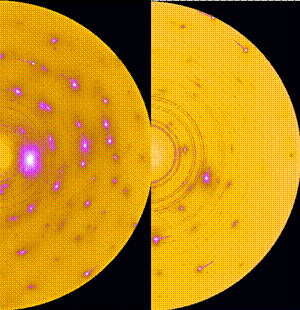Marcus Young, David Dunand, Joseph Lambert (NU Chemistry Department), Francesca Casadio (Art Institute of Chicago), and Suzie Schnepp are collaborating on this project, which involves analyzing the composition and patinas of modern bronzes by artists such as Matisse (See Figure 1), Brancusi, and Picasso. Read more...
FIGURE 1(left): Front view of Matisse's The Serf (AIC: 1949.202) from the Art Institute of Chicago. FIGURE 1 (right): Bronze dagger-axe (Ge, 3rd/2nd century B.C.; AIC 1950.1627; dimensions: 20 x 13 cm) . Photo Courtesy of the Art Institute of Chicago , Conservation Department. |
Another example of the Artistic bronze research and investigating the casting technology of bronzes from the early Western Zhou Dynasty using the powerful X-rays at Argonne's Advanced Photon Source is a bronze dagger-axe (Ge, 3rd/2nd century B.C.) with silver-inlaid sheath shown in Figure 1 (right). Here, Marcus, David, and Francesca answered a longstanding question about whether the dagger-axe concealed a functional interior blade or whether it was cast as a single piece, consistent with a purely ceremonial function. Due to the amount of corrosion, it would be impossible to separate a blade from a sheath without damaging the dagger-axe. However, by using both high-energy synchrotron x-ray diffraction and phase-contrast, edge-enhanced synchrotron radiation imaging with the help of Dr. Dean R. Haeffner, Dr. Jon Almer, Dr. Wah-Keat Lee, and Dr. Kamel Fezzaa at the Advanced Photon Source at Argonne National Laboratory, we were able to non-destructively investigate the internal structure of the dagger axe as shown in Figure 2b.
Figure 2a shows a traditional x-ray radiograph of the mid-section of the dagger-axe as compared to a mosaic of synchrotron x-ray phase-contrast, edge-enhanced images of the same mid-section of the dagger-axe. Synchrotron x-ray phase-contrast, edge-enhanced imaging has significantly better resolution than conventional x-ray radiography and, thus shows extremely sharp detail and improved contrast revealing the internal structure of the dagger-axe including the intricate shape of the silver inlay and allowing for the determination that no blades is present within the object and that it is indeed cast as a single piece and most likely only used as a ceremonial object.
FIGURE 2: a) Traditional x-ray radiograph of the mid-section of the dagger-axe and b) a mosaic of synchrotron x-ray phase-contrast, edge-enhanced images of the same mid-section of the dagger-axe. |
Although not shown here, high-energy x-ray diffraction mapping also confirmed this result. Additionally, the diffraction patterns also indicated the processing techniques used to make the dagger-axe. Shown in Figure 3 a-b, synchrotron x-ray diffraction patterns were collected while scanning vertically a 1mm long section with the 200 x 200 mm 2 beam. The individual diffraction spots in Figure 3a were collected over a region of predominately bronze with a small amount of surface corrosion and no silver inlay. The very large grain size implied by these large diffraction spots confirms that the object was most likely slow-cooled on solidification, along large dendrites seen in the radiographic images not shown here. The thin rings resulting from polycrystalline silver diffraction in Figure 3b were collected over a region with a combination of bronze, corrosion, and silver inlay. The rings are indicative of fine-grain silver, from which it can be deduced that the inlays were mechanically applied onto the bronze object (most probably by hammering) after the casting step.
FIGURE 3: Synchrotron x-ray diffraction patterns collected by scanning over 0.2 x 1 mm 2 regions consisting of (a) predominately bronze with a small amount of surface corrosion and no silver inlay and (b) a combination of bronze, corrosion layers, and silver inlay. |
Another interesting aspect of diffraction from the region with a combination of bronze, corrosion, and silver inlay was the ability to show that indeed internal structure of different materials embedded within objects is observable. The double rings visible in Figure 3b are due to the fact that silver is inlaid on both faces of the sheath, illustrating that synchrotron diffraction can be used to study metallic layers buried under corrosion products and separated by several millimeters of leaded bronze.
Related Publications
-
M.L. Young, F. Casadio, S. Schnepp, J. Almer, D.R. Haeffner, D.C. Dunand. "Synchrotron X-ray diffraction and imaging of ancient Chinese bronzes." Applied Physics A-Materials Science & Processing 83 (2): 163-168 May 2006
 PDF
PDF -
M.L. Young, S. Schnepp, F. Casadio, A. Lins, M. Meighan, J.B. Lambert, D.C. Dunand. "Matisse to Picasso: a compositional study of modern bronze sculptures." Anal Bioanal Chem 395: 171-184 2009
 PDF
PDF
Financial Support
This research is funded by The Mellon Foundation and is part of the Art/Science Conservation collaboration between the Art Institute of Chicago and NU.




